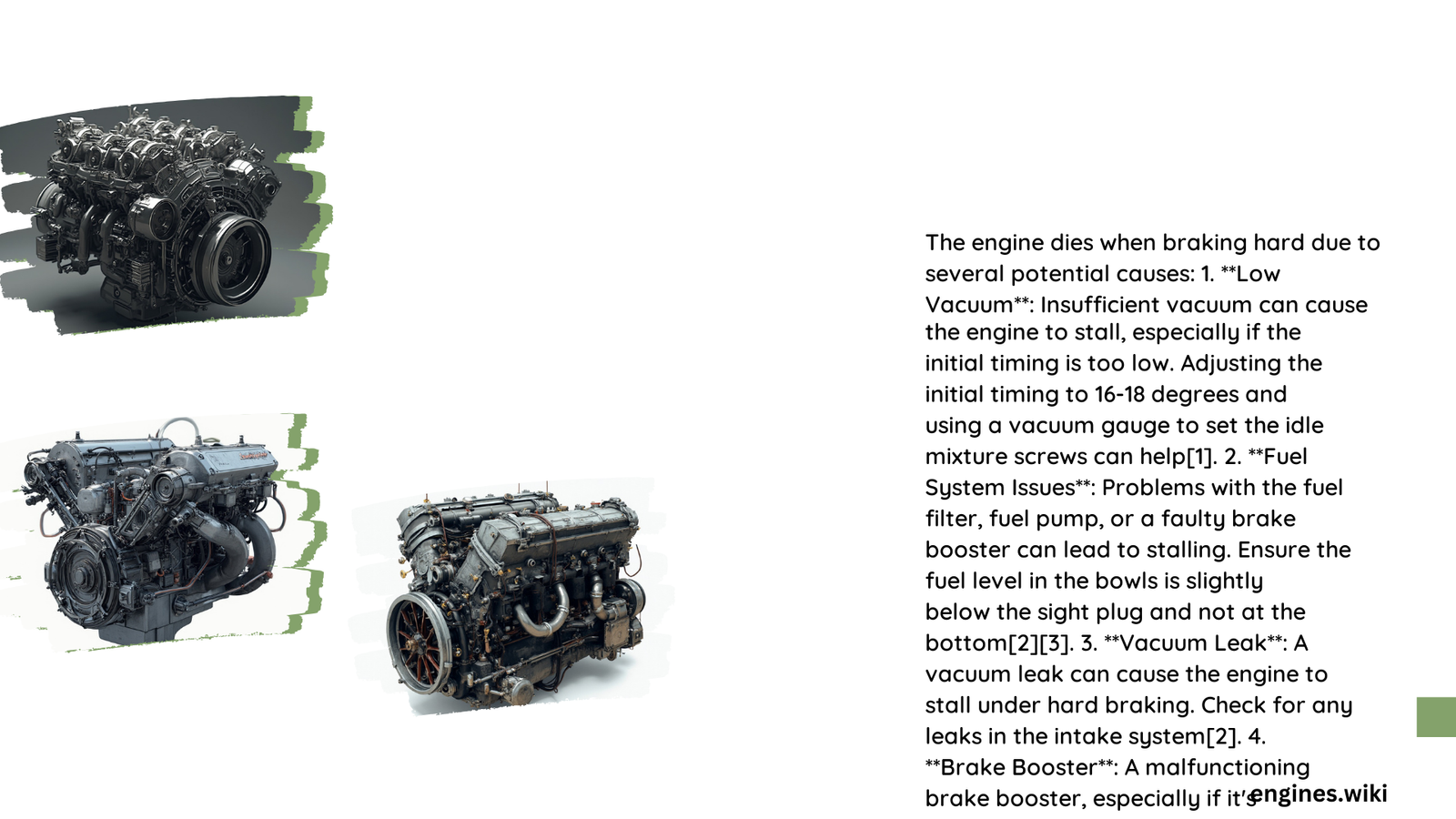When an engine dies when braking hard, it can be a frustrating and potentially dangerous issue. This problem is often caused by a combination of mechanical and electronic factors, including vacuum system failures, fuel delivery issues, and ignition timing problems. Understanding these causes and their solutions is crucial for maintaining vehicle safety and performance. This article explores the various reasons behind engine stalling during hard braking and provides practical solutions to address this common automotive concern.
Why Does My Engine Die When I Brake Hard?
The phenomenon of an engine dying when braking hard is typically related to several key factors:
- Vacuum system failures
- Fuel delivery interruptions
- Ignition and timing issues
- Clutch and transmission problems (in manual vehicles)
Let’s delve deeper into each of these factors to understand their impact on engine performance during hard braking.
What Role Does the Vacuum System Play in Engine Stalling?
The vacuum system is a critical component in many vehicles, particularly those with vacuum-assisted brake systems. When you brake hard, the demand for vacuum increases significantly. If there’s a problem with the vacuum system, it can lead to engine stalling. Here’s why:
- Vacuum Brake Booster: A faulty or leaking brake booster can create an unwanted air path into the engine, causing it to run poorly and stall.
- Vacuum Pressure: A healthy vacuum system typically maintains a pressure between 15-20 inches of mercury (inHg) at idle. A leak can drop this pressure below 10 inHg, potentially causing the engine to stall.
- Master Cylinder Seal: A failing seal in the master cylinder can also contribute to vacuum leaks, affecting engine performance during hard braking.
To diagnose vacuum system issues:
- Check for any hissing sounds that might indicate a leak.
- Use a vacuum gauge to measure the system’s pressure at idle.
- Inspect all vacuum lines and connections for signs of wear or damage.
How Does Fuel Delivery Affect Engine Performance During Hard Braking?
Fuel delivery problems can significantly impact engine performance, especially during hard braking. Here’s what you need to know:
- Fuel Sloshing: In carbureted engines, hard braking can cause fuel to slosh forward in the carburetor bowls, potentially uncovering the main fuel circuit and leading to engine stumbling or stalling.
- Fuel Pressure: Maintaining correct fuel pressure is crucial. For example, a Holley 650 DP carburetor typically requires 3.5-4.5 PSI.
- Float Level: Ensuring the proper float level in carbureted engines is essential to prevent fuel starvation during hard braking.
To address fuel delivery issues:
- Check and adjust the float level in carbureted engines.
- Consider using jet extensions to keep main jets submerged in fuel.
- Verify fuel pump functionality and pressure.
What Impact Does Ignition Timing Have on Engine Stalling?
Incorrect ignition timing can exacerbate stalling issues during hard braking. Here’s how:
- Retarded Timing: If the initial timing is too low, it can result in insufficient vacuum, leading to stalling.
- Optimal Timing: For many engines, setting the initial timing to 16-18 degrees can help prevent stalling issues.
To adjust ignition timing:
- Use a timing light to check and adjust the initial timing.
- Ensure the distributor is in good condition and functioning correctly.
- Consider using a vacuum gauge to set the idle mixture screws for optimal performance.
How Can Clutch and Transmission Issues Cause Engine Stalling?
In manual transmission vehicles, improper clutch management during hard braking can lead to engine stalling:
- Clutch Engagement: Failing to engage the clutch or switch into neutral during hard braking can cause a mismatch between engine revs and deceleration rate, leading to stalling.
- Transmission Wear: Worn transmission components can exacerbate this issue, making it more difficult to maintain proper engine speed during braking.
To prevent clutch-related stalling:
- Practice proper clutch management during hard braking scenarios.
- Ensure regular maintenance of the clutch and transmission system.
- Consider upgrading to a higher-performance clutch if frequent hard braking is necessary.
What Vehicles Are Most Susceptible to Engine Stalling During Hard Braking?

While this issue can affect various vehicles, some are more prone to experiencing engine stalling during hard braking:
- Carbureted engines (e.g., classic cars and older models)
- Vehicles with vacuum-assisted brake systems
- Some specific models, such as:
- 1988 Alfa 75 3.0 V6
- 1992 Camaro RS
- 2014 Ram Outdoorsman (with electronic throttle bodies)
It’s important to note that even modern vehicles with electronic systems can experience similar issues, often due to different underlying causes.
How Can I Diagnose and Fix Engine Stalling During Hard Braking?
To diagnose and address engine stalling during hard braking, follow these steps:
- Check the Vacuum System:
- Inspect all vacuum lines for leaks or damage
- Use a vacuum gauge to measure system pressure
-
Replace any faulty components, including the brake booster if necessary
-
Verify Fuel Delivery:
- Check fuel pressure and adjust if needed
- Inspect carburetor float levels (for carbureted engines)
-
Consider installing jet extensions in carbureted engines
-
Adjust Ignition Timing:
- Use a timing light to check and adjust initial timing
- Ensure distributor is functioning correctly
-
Set idle mixture screws using a vacuum gauge
-
Inspect Clutch and Transmission (for manual vehicles):
- Check clutch wear and adjustment
- Verify proper transmission function
-
Practice proper clutch management during hard braking
-
Consult a Professional:
- If issues persist, seek help from a qualified mechanic
- Consider specialized diagnostics for electronic systems in modern vehicles
By systematically addressing these potential causes, you can effectively diagnose and resolve the issue of engine stalling during hard braking, ensuring safer and more reliable vehicle operation.
